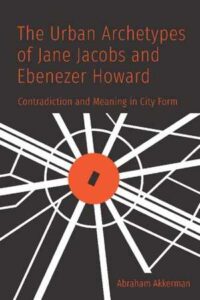نام کتاب: The Urban Archetypes Of Jane Jacobs And Ebenezer Howard – Contradiction And Meaning In City Form
نویسنده: Abraham Akkerman
ویرایش: ۱
سال انتشار: ۲۰۲۰
کد ISBN کتاب: ۹۷۸۱۴۸۷۵۰۱۲۶۶, ۹۷۸۱۴۸۷۵۱۲۸۲۸, ۹۷۸۱۴۸۷۵۱۲۸۱۱,
فرمت: PDF
تعداد صفحه: ۲۷۵
حجم کتاب: ۱۰ مگابایت
کیفیت کتاب: OCR
انتشارات: University Of Toronto Press
Description About Book The Urban Archetypes Of Jane Jacobs And Ebenezer Howard – Contradiction And Meaning In City Form From Amazon
Ebenezer Howard, an Englishman, and Jane Jacobs, a naturalized Canadian, personify the twentieth century’s opposing outlooks on cities. Howard envisaged small towns, newly built from scratch and comprised of single-family homes with small gardens, while Jacobs embraced existing inner-city neighbourhoods that emphasized the verve of the living street. Both figures have had their share of supporters as well as detractors: Howard’s conceptualization received criticism for its uniformity and alienation from the city core, while Jacobs’s urban vision came to be recognized as the result of invasive gentrification.
Presenting Howard and Jacobs within a psychocultural context, The Urban Archetypes of Jane Jacobs and Ebenezer Howard addresses our urban crisis in its recognition that “city form is a gendered, allegorical medium expressing femininity and masculinity within two founding features of the built environment: void and volume.” These founding contrasts represent both tension as well as the opportunity for fusion between pairs of urban polarities: human scale against superscale, gait against speed, and spontaneity against surveillance. In their respective attitudes, Howard and Jacobs have come to embrace the two ancient archetypes of the Garden and the Citadel, leaving it to future generations to blend their two contrarian stances.
درباره کتاب The Urban Archetypes Of Jane Jacobs And Ebenezer Howard – Contradiction And Meaning In City Form ترجمه شده از گوگل
Ebenezer Howard ، یک انگلیسی ، و Jane Jacobs ، یک کانادایی تبعه طبیعی ، چشم اندازهای مخالف قرن بیستم را در شهرها مجسم می کنند. هوارد شهرهای کوچکی را در نظر گرفت ، تازه از ابتدا ساخته شده و از خانه های تک خانواده با باغ های کوچک تشکیل شده بود ، در حالی که جیکوبز محله های موجود در داخل شهر را که از خیابان مخصوص خیابان تأکید می کرد ، در آغوش گرفت. هر دو شخصیت از طرفداران و مخالفان خود برخوردار بوده اند: ایده پردازی هاوارد به دلیل یکنواختی و بیگانگی آن از هسته اصلی شهر انتقاداتی را دریافت کرد ، در حالی که دیدگاه شهری جیکوبز به عنوان نتیجه جنتریفاسیون تهاجمی شناخته شد.
با ارائه هوارد و جیکوبز در یک چارچوب روانی فرهنگی ، کهن الگوهای شهری جین جیکوبز و ابنزر هاوارد به بحران شهری ما می پردازد ، زیرا “شکل شهر یک رسانه جنسیتی و تمثیلی است که بیانگر زنانگی و مردانگی در دو ویژگی بنیادی محیط ساخته شده است: بی اعتبار و جلد.” این تضادهای بنیادی نشان دهنده تنش و همچنین فرصتی برای همجوشی بین جفت قطب های شهری است: مقیاس انسانی در برابر مقیاس فوق العاده ، راه رفتن در برابر سرعت و خودانگیختگی در برابر نظارت. هاوارد و جیکوبز در نگرش های خود به استقبال دو کهن الگوهای باستانی باغ و ارگ رفته اند و تلفیق دو موضع مخالف خود را به نسل های بعدی واگذار کرده اند.
[box type=”info”]![]() جهت دسترسی به توضیحات این کتاب در Amazon اینجا کلیک کنید.
جهت دسترسی به توضیحات این کتاب در Amazon اینجا کلیک کنید.![]() در صورت خراب بودن لینک کتاب، در قسمت نظرات همین مطلب گزارش دهید.
در صورت خراب بودن لینک کتاب، در قسمت نظرات همین مطلب گزارش دهید.

